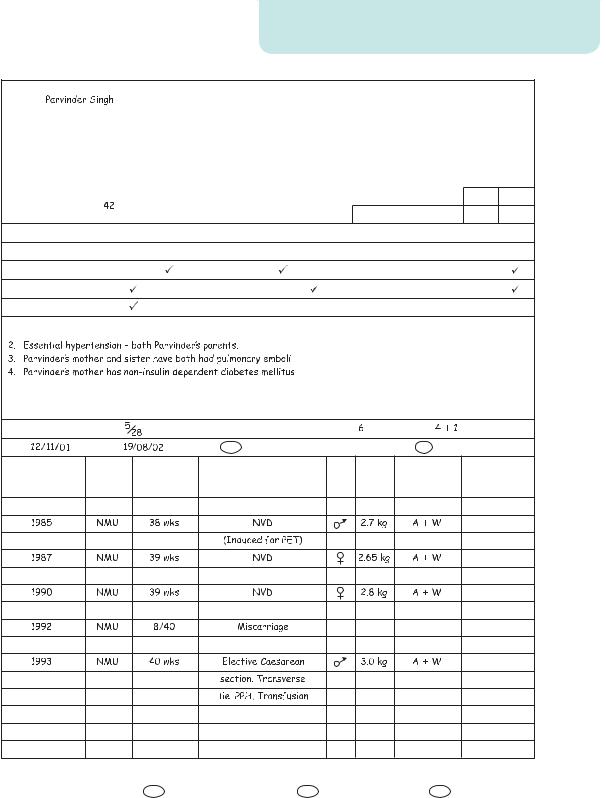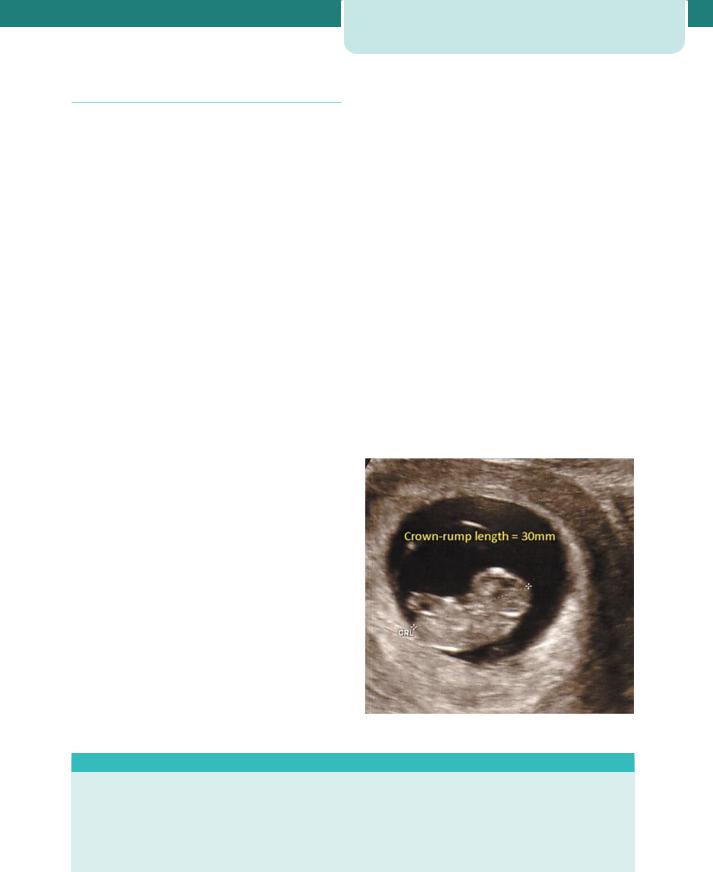
Obstetrics_by_Ten_Teachers_19E_-_Kenny_Louise
.pdf
46 Normal fetal development and growth
C A S E H I S T O R Y continued
transfusion, iron supplementation or, in some cases, the use of erythropoietin.
Immune system
Preterm babies have an increased susceptibility to infection due to impaired cell-mediated immunity and reduced levels of immunoglobulin. Suspected infection should be treated early with antibiotics because deterioration in these premature small infants can be rapid.
Skin and homeostasis
Hypothermia is common in preterm infants secondary to a relatively large body surface area, thin skin, lack of subcutaneous fat and lack of a keratinized epidermal layer of skin. High insensible water losses due to skin immaturity may aggravate dehydration and electrolyte problems secondary to immaturity in renal function (see below). The environment can be controlled by nursing this type of infant in an incubator.
Alimentary system
Necrotizing enterocolitis is an inflammatory condition of the bowel leading to necrosis, and is thought to be secondary to alterations in gut blood flow, hypotension, hypoxia, infection and feeding practices. Feeding problems are common in preterm infants because they have immature suck and swallowing reflexes and
gut motility. Parenteral nutrition is usually required in these very premature infants, with gradually increasing volumes of milk given by nasogastric tube.
Liver and gall bladder
Jaundice (hyperbilirubinaemia) secondary to liver immaturity and a shorter half-life of red blood cells is common in premature infants. Treatment with phototherapy is required because premature infants are at greater risk of bilirubin encephalopathy.
Kidney and urinary tract
Immaturity of the kidneys can lead to a poor ability to concentrate or dilute urine. This can result in dehydration and electrolyte disturbances: hypernatraemia and hyponatraemia, hyperkalaemia and metabolic acidosis.
Neurological
Periventricular and intraventricular haemorrhages result from bleeding from the immature rich capillary bed of the germinal matrix lining the ventricles. Such haemorrhages are more likely in the presence of hypoxia. Major degrees of haemorrhage can result in hydrocephalus and neurological abnormalities such as cerebral palsy. Periventricular leukomalacia is ischaemic necrosis in the white matter surrounding the lateral ventricles, and commonly leads to cerebral palsy.
C A S E H I S T O R Y
A 16-year-old is admitted to the labour ward at 38 weeks gestation. She gives a history suggestive of rupture of membranes and is experiencing uterine contractions. She was seen at 10 weeks gestation for consideration of termination of pregnancy and had a scan at that time which confirmed her gestational age. She opted to continue with the pregnancy but did not attend for antenatal care. She admitted to smoking 20 cigarettes per day. Vaginal examination confirms that the cervix is 8 cm dilated. A CTG demonstrates a baseline fetal heart rate of 165 bpm with variable decelerations, and fetal scalp pH is 7.14 with a base deficit of 12 mmol/L.
A Caesarean section is performed and a male infant weighing 1900 g is delivered. Apgar scores are 3 at 1 minute and 8 at 5 minutes.
From which complications are such severely
growth-restricted infants particularly at risk?
Reduced oxygen supply in utero can result in the fetus being stillborn or suffering damage from acute asphyxia. In the latter case, the neonate may demonstrate features of hypoxic ischaemic
encephalopathy (HIE), which may lead to death from multiorgan failure. If the infant survives, neurological damage and cerebral palsy may result. Chronic hypoxia in utero can also result in neurological damage without the acute manifestations of HIE. Other consequences of reduced oxygen supply in utero include increased haemopoiesis and cardiac failure. Increased haemopoiesis can in turn result in coagulopathy, polycythaemia and jaundice in the newborn.
Neonatal hypothermia and hypoglycaemia are also more common in this type of infant and result from reduced body fat and glycogen stores. Both of these conditions, if untreated, can lead to increased mortality and neurological damage.
Reduced supply of amino acids in utero can impair immune function, increasing the risk of infection in the newborn.
Growth-restricted babies are also at increased risk of chronic diseases such as coronary heart disease, stroke, hypertension and non-insulin-dependent diabetes in adulthood. This is thought to be because the fetal adaptation to undernutrition in utero results in the permanent resetting of homeostatic mechanisms, and this leads to later disease.

|
|
Amniotic fluid |
47 |
Key points
•Determinants of birth weight are multifactorial, and reflect the influence of the natural growth potential of the fetus and the intrauterine environment.
•The fetal circulation is quite different from that of the adult. Its distinctive features are:
•oxygenation occurs in the placenta, not the lungs;
•the right and left ventricles work in parallel rather than in series;
•the heart, brain and upper body receive blood from the left ventricle, while the placenta and lower body receive blood from both right and left ventricles.
•Surfactant prevents collapse of small alveoli in the lung during expiration by lowering surface tension. Its production is maximal after 28 weeks.
•Respiratory distress syndrome is specific to babies born prematurely and is associated with surfactant deficiency.
•The fetus requires an effective immune system to resist intrauterine and perinatal infections. Lymphocytes appear from 8 weeks and, by the middle of the second trimester, all phagocytic cells, T and B cells and complement are available to mount a response.
•Fetal skin protects and facilitates homeostasis.
•In utero, the normal metabolic functions of the liver are performed by the placenta. The loss of the placental route of excretion of unconjugated bilirubin, in the face of conjugating enzyme deficiencies, particularly in the premature infant, may result in transient unconjugated hyperbilirubinaemia or physiological jaundice of the newborn.
•Growth-restricted and premature infants have deficient glycogen stores; this renders them prone to neonatal hypoglycaemia.
•The function of the amniotic fluid is to:
•protect the fetus from mechanical injury;
•permit movement of the fetus while preventing limb contracture;
•prevent adhesions between fetus and amnion;
•permit fetal lung development in which there is twoway movement of fluid into the fetal bronchioles; absence of amniotic fluid in the second trimester is associated with pulmonary hypoplasia.

C H A P T E R 5
A N T E N A T A L C A R E
Alec McEwan
............................................................................Aims of antenatal care |
48 |
....................................................Screening for fetal abnormalities |
57 |
Classification of antenatal care......................................................... |
49 |
Screening for clinical conditions later in pregnancy........... |
57 |
Advice, reassurance and education............................................... |
49 |
Follow-up visits ........................................................................................... |
58 |
Accessing antenatal care: the ‘booking visit’.......................... |
52 |
Customized antenatal care .................................................................. |
58 |
|
|
|
|
O V E R V I E W
The overall purpose of antenatal care is to optimize the outcome of pregnancy for the mother, her child and the rest of her family.
History taking, examination and the use of investigations are tailored to each individual pregnancy to assess risk and to screen for potential physical, psychological and social problems.
If a potential problem is identified, appropriate action can be taken to minimize the impact it has on the pregnancy. This may involve recruiting help from other professionals.
Models of antenatal care vary throughout the world. Although this chapter discusses the UK model, the principles of high calibre care targeted at the woman’s needs are applicable throughout all health care settings.
Aims of antenatal care
The aims of antenatal care are:
•to prevent, detect and manage those factors that adversely affect the health of mother
and baby;
•to provide advice, reassurance, education and support for the woman and her family;
•to deal with the ‘minor ailments’ of pregnancy;
•to provide general health screening.
The original model of antenatal care established in the 1930s involved as many as 15 visits to a doctor or a midwife. This scheme was not evidence based but persisted for many years because of fears that reducing the number of visits would lead to an increase in maternal and perinatal morbidity and mortality. Newer models of antenatal care have questioned the need for so many reviews and in problem-free pregnancies without additional risk factors there is no evidence that fewer visits compromise outcomes. However, the identification of factors which may increase the risks of complications is critical if extra
care is to be appropriately targeted. Risk assessment should be viewed as an ongoing exercise throughout the pregnancy so that the type of care offered to a woman can change as new issues and concerns come to light. The community midwife should be seen as the overall coordinator of care, assisting the woman to access specialist services as and when they become necessary. Even if no adverse factors are identified, a minimum standard of care is still to be expected. This chapter focuses on this basic plan for antenatal care and describes how the process of risk assessment is carried out.
The newest models of antenatal care aim to make the woman the focus. Women should be treated with kindness and dignity at all times, and due respect given to personal, cultural and religious beliefs. Services should be readily accessible and there should be continuity of care. There is a need for high quality, culturally appropriate, verbal and written information on which women can base their choices, through a truly informed decisionmaking process which is led by them. This may seem obvious, however, it remains the case that many pregnant women struggle to engage with what they

currently see as a rigid non-individualized system of antenatal care which they feel does not serve their best interests.
Classification of antenatal care
In the UK, maternity care for an individual woman is provided by a community-based team of midwives and GPs, a hospital consultant team, or a combination of the two. A small number of women have such complex pregnancies that the vast majority of their antenatal care is provided by a hospital-based obstetric team and they are said to have ‘consultant care’. Many more women have pregnancies where there are no overtly complicating factors and these women usually have community-based care and are said to be ‘booked under the midwife’. A further group have factors identified at booking, for example previous Caesarean section, which mandate involvement by obstetricians but where the majority of routine care can still be provided by the community team. Some call this ‘shared care’.
In reality, these distinctions are blurred. Women with highly complex pregnancies may nevertheless find helpful the different kind of support and information provided by their community midwife, while women booked under midwifery care will frequently attend hospital day assessment units, and sometimes consultant clinics, when concerns arise. They need not necessarily be reclassified as consultant care if no problem is identified. It remains important though that the woman herself knows who is primarily responsible for the provision of her antenatal care.
Ultrasound scanning is usually performed in a maternity unit, whatever kind of care is accessed. Dating and detailed scans will be organized for a woman whether she is community or consultant booked. There is, however, a movement towards also offering these specialist scanning services in the community and, where this is already happening, there is no need for a woman with a straightforward pregnancy to have any antenatal care or investigation in hospital. Antenatal appointments in the community may be provided in GP surgeries, community hospitals, polyclinics and children’s centres. Women should be able to access maternity care easily and should be seen in an environment that allows the
Advice, reassurance and education |
49 |
confidential and safe discussion of difficult issues such as domestic violence, sexual abuse, psychiatric illness and substance misuse.
Most women booked under a hospital consultant will have risk factors which recommend delivery of the baby within the obstetric maternity unit, but not all. It may be entirely reasonable for a consultant-booked patient to later choose a home birth, for example. This will depend on the original reason for referral to the consultant. Community-booked women may have a choice between home birth, delivery in a midwife run unit, or delivery in a consultant unit. In some areas, women who are booked with a community midwife, but who choose delivery in hospital, may be looked after in labour by a member of the community team who attends hospital for the birth. This continuity of care can be difficult to achieve.
Whichever form of care is chosen, a pregnant woman will receive a set of client-held records in which all healthcare professionals will write each time she is seen. The booking proforma (Figure 5.1) is found within these notes, as are the results of investigations and plans for the delivery. This improves communication and allows access for all healthcare staff to the same information.
Most maternity units now also provide day-care facilities. Hospital-booked or communitybooked patients can be referred to these units for assessment or review of a wide variety of antenatal problems, including hypertension in pregnancy and reduced fetal movements. The units are staffed by experienced midwives, many of whom are trained in ultrasonography. Day-care units help to reduce admissions to antenatal wards which can cause enormous social and domestic disruption.
Advice, reassurance and education
Pregnancy is a time of great uncertainty, and the physical changes experienced by the woman during her pregnancy add to this. She may need explanation and reassurance to help her cope with a wide variety of symptoms, including nausea, heartburn, constipation, shortness of breath, dizziness, swelling, backache, abdominal discomfort and headaches. Mostly, these represent the physiological adaptation of her body to the pregnancy and are often called the ‘minor complaints’ of pregnancy. Although usually

|
|
|
|
|
|
|
|
|
|
|
|
|
|
|
|
|
|
|
|
|
|
|
|
|
|
50 |
Antenatal care |
|
|
|
|
|
|
|
|
|
|
|
|
|
|
|
|
|
|
|
|
|
|||
|
|
|
|
|
|
|
|
|
|
|
|
|
|
|
|
|
|
|
|
|
|
|
|
||
|
|
|
NAME/ADDRESS/POSTCODE: |
|
|
|
AFFIX PATIENT |
D.O.B: |
DATE OF BOOKING |
|
|
|
|
||||||||||||
|
|
|
|
|
|
|
|
|
|
IDENTIFICATION |
|
|
|
|
|
|
|
|
|
|
|
|
|
|
|
|
|
|
|
|
|
|
|
|
|
Religion: |
Marital Status: |
|
|
|
|
|
|
|
|
||||||
|
|
|
|
|
|
|
|
|
|
|
LABEL HERE |
|
|
|
|
|
|
|
|
||||||
|
|
|
|
|
|
|
|
|
|
|
|
|
|
|
|
|
|
|
|
|
|
|
|
|
|
|
|
|
|
|
|
|
|
|
|
IF AVAILABLE |
|
|
|
|
Previous Name/s: |
|
|
|
|
|
|
|
|||
|
|
|
|
|
|
|
|
|
|
|
|
|
|
|
|
|
|
|
|
|
|
|
|||
|
|
|
|
|
|
|
|
|
|
|
|
|
|
|
|
|
|
|
|
|
|
|
|
||
|
|
|
|
|
|
|
|
|
|
ALTERNATIVELY |
|
|
|
|
Country of Origin: |
|
|
|
|
|
|
|
|||
|
|
|
|
|
|
|
|
|
|
|
|
|
|
|
|
|
|
|
|
|
|
|
|
||
|
|
|
|
|
|
|
|
|
|
|
WRITE |
|
|
|
|
ETHNIC GROUP |
|
|
Patient |
|
Partner |
|
|||
|
|
|
|
|
|
|
|
|
|
INFORMATION |
|
|
|
|
|
|
|
|
|||||||
|
|
|
|
|
|
|
|
|
|
|
|
|
|
|
|
|
|
|
|
|
|
|
|
||
|
|
|
|
|
|
|
|
|
|
|
|
|
|
|
|
|
|
|
|
|
|
|
|
||
|
|
|
|
|
|
|
|
|
IN BOX PROVIDED |
|
|
|
|
White |
|
|
|
|
|
|
|
|
|||
|
|
|
|
|
|
|
|
|
|
|
|
|
|
|
|
|
|
|
|
|
|
|
|||
|
|
|
Telephone Home: |
|
|
|
|
|
Telephone Work: |
|
|
|
|
Black Caribbean |
|
|
|
|
|
|
|
||||
|
|
|
|
|
|
|
|
|
|
|
|
|
|
|
|
|
|
|
|
|
|
|
|
||
|
|
|
HOSPITAL No. |
|
|
|
|
|
OCCUPATION: |
|
|
|
|
Black African |
|
|
|
|
|
|
|
|
|||
|
|
|
|
|
|
|
|
|
|
|
|
|
|
|
|
|
|
|
|
|
|||||
|
|
|
CONSULTANT: |
|
|
|
|
|
PARTNER’S OCCUPATION: |
Black Other |
|
|
|
|
|
|
|
|
|||||||
|
|
|
|
|
|
|
|
|
|
|
|
|
|
|
|
|
|
|
|
|
|
|
|
||
|
|
|
PLACE OF DELIVERY: |
|
|
|
|
|
NHS No: |
|
|
|
|
Indian |
|
|
|
|
|
|
|
|
|||
|
|
|
|
|
|
|
|
|
|
|
|
|
|
|
|
|
|
|
|
||||||
|
|
|
LMP: |
EDD: |
|
|
|
Silver Stat Card |
Y/N |
Pakistani |
|
|
|
|
|
|
|
|
|||||||
|
|
|
|
|
|
|
|
|
|
|
|
|
|
|
|
|
|
|
|
||||||
|
|
|
FAMILY DOCTOR: |
|
Address: |
|
|
|
Telephone No: |
Bangladeshi |
|
|
|
|
|
|
|
|
|||||||
|
|
|
Name: |
|
|
|
|
|
|
|
|
|
|
|
|
|
|
|
|
|
|
|
|
||
|
|
|
|
|
|
|
|
|
|
|
|
|
|
Chinese |
|
|
|
|
|
|
|
|
|||
|
|
|
|
|
|
|
|
|
|
|
|
|
|
|
|
|
|
|
|||||||
|
|
|
HUSBAND/PARTNER |
|
Address: |
|
|
|
Telephone No: |
Any other group |
|
|
|
|
|
|
|
||||||||
|
|
|
Name: |
|
|
|
|
|
|
|
|
|
|
|
|
|
|
|
|
|
|
|
|
||
|
|
|
|
|
|
|
|
|
|
|
|
|
|
Not Given |
|
|
|
|
|
|
|
|
|||
|
|
|
|
|
|
|
|
|
|
|
|
|
|
|
|
|
|
|
|
|
|
|
|
||
|
|
|
NEXT OF KIN: |
|
Address: |
|
|
|
Telephone No: |
|
|
|
|
|
|
|
|
|
|
||||||
|
|
|
Relationship: |
|
|
|
|
|
|
|
|
|
|
|
|
|
|
|
|
|
|
|
|
|
|
|
|
|
|
|
|
|
|
|
|
|
|
|
|
|
|
|
|
|
|
||||||
|
|
|
Computer information explained |
Y/N |
|
|
|
Signature of Midwife |
Printed Name: |
|
|
|
|
|
|
|
|
||||||||
|
|
|
|
|
|
|
|
|
|
|
|
|
|
|
|
|
|
|
|
|
|
|
|
||
|
|
|
Social Worker |
|
|
|
|
|
|
Telephone: |
|
|
|
|
Referral Date: |
|
|
|
|
|
|
|
|
||
|
|
|
|
|
|
|
|
|
|
|
|
|
|
|
|
|
|
||||||||
|
|
|
|
MEDICAL AND SURGICAL HISTORY |
|
|
|
|
ANTENATAL INVESTIGATION |
|
|||||||||||||||
|
|
|
|
|
|
|
|
|
|
|
|
|
|
|
|
|
|
|
|
|
|
|
|
|
|
|
|
|
|
|
|
YES |
NO |
|
|
|
|
|
YES |
NO |
|
BOOKING |
|
|
DATE |
|
RESULT |
|
|||
|
|
|
|
|
|
|
|
|
|
|
|
|
|
|
|
|
|
|
|
|
|
|
|
|
|
|
|
1. |
Cardiac/Hypertension |
|
|
14. |
Special Diet |
|
|
|
|
B.T.S. Number |
|
|
|
|
|
|
|
|
|||||
|
|
|
|
|
|
|
|
|
|
|
|
|
|
|
|
|
|
|
|
|
|
|
|
||
|
|
2. |
Thromboembolism |
|
|
|
15. |
Vegetarian |
|
|
|
|
ABO Group |
|
|
|
|
|
|
|
|
||||
|
|
|
|
|
|
|
|
|
|
|
|
|
|
|
|
|
|
|
|
|
|
|
|
||
|
|
3. |
Respiratory |
|
|
|
16. |
Drug Misuse |
|
|
|
|
Antibodies |
|
|
|
|
|
|
|
|
||||
|
|
|
|
|
|
|
|
|
|
|
|
|
|
|
|
|
|
|
|
|
|
|
|
||
|
|
4. |
Renal |
|
|
|
17. |
Bacterial Infections |
|
|
|
H.I.V. |
|
|
|
|
|
|
|
|
|||||
|
|
|
|
|
|
|
|
|
|
|
|
|
|
|
|
|
|
|
|
|
|
|
|
||
|
|
5. |
Alimentary |
|
|
|
18. |
Viral Infections |
|
|
|
|
VDRL |
|
|
|
|
|
|
|
|
||||
|
|
|
|
|
|
|
|
|
|
|
|
|
|
|
|
|
|
|
|
|
|
|
|
|
|
|
|
6. |
Liver |
|
|
|
19. |
Chickenpox |
|
|
|
|
Hepatitis |
|
A |
|
|
|
|
|
|
|
|||
|
|
|
|
|
|
|
|
|
|
|
|
|
|
|
|
|
|
|
|
|
|
|
|
|
|
|
|
7. |
Endocrinological |
|
|
|
20. |
Genetic |
|
|
|
|
|
|
B |
|
|
|
|
|
|
|
|||
|
|
|
|
|
|
|
|
|
|
|
|
|
|
|
|
|
|
|
|
|
|
|
|
|
|
|
|
8. |
Neurological |
|
|
|
21. |
Previous Surgery |
|
|
|
|
|
|
C |
|
|
|
|
|
|
|
|||
|
|
|
|
|
|
|
|
|
|
|
|
|
|
|
|
|
|
|
|
|
|
|
|
|
|
|
|
9. |
Haematological |
|
|
|
22. |
Previous Infertility |
|
|
|
|
Electrophoresis |
|
|
|
|
|
|
|
|||||
|
|
|
|
|
|
|
|
|
|
|
|
|
|
|
|
|
|
|
|
|
|
|
|
||
|
|
10. |
Blood Transfusion |
|
|
|
23. |
Other |
|
|
|
|
Rubella Titre |
|
|
|
|
|
|
|
|
||||
|
|
|
|
|
|
|
|
|
|
|
|
|
|
|
|
|
|
|
|
|
|
|
|
||
|
|
11. |
Contraception |
|
|
|
24. |
Mental Health |
|
|
|
|
AFP |
|
|
|
|
|
|
|
|
||||
|
|
|
|
|
|
|
|
|
|
|
|
|
|
|
|
|
|
|
|
|
|
|
|
||
|
|
12. |
Drugs in Pregnancy |
|
|
|
25. |
Alcohol (units per week) |
|
|
|
MSU |
|
|
|
|
|
|
|
|
|||||
|
|
|
|
|
|
|
|
|
|
|
|
|
|
|
|
|
|
|
|
|
|
|
|
||
|
|
13. |
Allergies |
|
|
|
26. |
Smoking |
|
|
|
|
Cytology |
|
|
|
|
|
|
|
|
||||
|
|
|
|
|
|
|
|
|
|
|
|
|
|
|
|
|
|
|
|
|
|
|
|
|
|
|
|
|
COMMENTS: |
|
|
|
|
|
|
|
|
|
|
|
Amniocentesis |
|
|
|
|
|
|
|
|
||
|
|
|
|
|
|
|
|
|
|
|
|
|
|
|
|
|
|
|
|
|
|
|
|
||
|
|
|
|
|
|
|
|
|
|
|
|
|
|
|
|
|
|
|
|
|
|
|
|
|
|
|
|
|
|
|
|
|
|
|
|
|
|
|
|
|
|
CVS |
|
|
|
|
|
|
|
|
|
|
|
|
|
|
|
|
|
|
|
|
|
|
|
|
|
|
|
|
|
|
|
|
|
||
|
|
|
|
|
|
|
|
|
|
|
|
|
|
|
|
Down’s Screening |
|
|
|
|
|
|
|
||
|
|
|
|
|
|
|
|
|
|
|
|
|
|
|
|
|
|
|
|
|
|
|
|
|
|
|
|
|
|
|
|
|
|
|
|
|
|
|
|
|
|
Other |
|
|
|
|
|
|
|
|
|
|
|
|
|
|
|
|
|
|
|
|
|
|
|
|
|
|
|
|
|
|
|
|
|||
|
|
|
|
|
|
|
|
|
|
|
|
|
|
|
|
PREVIOUS ANTI-D GIVEN |
|
YES/NO |
|
||||||
|
|
|
|
|
|
|
|
|
|
|
|
|
|
|
|
|
|
|
|
|
|
|
|
||
|
|
|
|
|
|
|
|
|
|
|
|
|
|
|
|
DATES GIVEN |
|
|
|
|
|
|
|
||
|
|
|
|
|
|
|
|
|
|
|
|
|
|
|
|
|
|
|
|
|
|
|
|
|
|
Figure 5.1 A typical booking proforma contained in patient-held records

|
|
Advice, reassurance and education |
51 |
Name: |
|
|
|
Hospital No. |
.......................................................................... |
|
|
|
|
||||||
PREVIOUS ANAESTHETIC PROBLEMS |
|
|
|
|
|
|
|
|
|
|
|
||||
(see anaesthetic referral guide lines) |
|
|
|
|
|
|
|
|
|
|
|
|
|||
Booking:- Weight |
|
|
|
|
|
|
|
|
|
|
|
|
|||
|
Height |
|
|
|
|
|
|
|
|
|
|
|
|
||
|
BM Index |
|
|
|
|
|
|
|
|
|
YES |
|
NO |
||
|
|
|
|
|
|
|
|
|
REFERRAL |
|
|
||||
|
|
|
|
|
|
|
|
|
|
|
|
|
|
||
|
|
|
|
|
|
FAMILY HISTORY |
|
|
|
|
|
||||
|
|
YES |
|
NO |
|
|
YES |
|
NO |
|
|
|
YES |
|
NO |
|
|
|
|
|
|
|
|
|
|
||||||
1. |
Multiple Birth |
|
|
|
4. |
Diabetes |
|
|
|
|
6. |
Congenital Abnormalities |
|
|
|
2. |
Hypertension |
|
|
|
5. |
Tuberculosis |
|
|
|
|
7. |
Deafness (Congenital) |
|
|
|
3. |
Thromboembolism |
|
|
|
|
|
|
|
|
|
|
|
|
|
|
|
|
|
Other |
|
|
|
|
|
|||||||
|
|
|
|
|
|
|
|
|
|
|
|
|
|
|
|
Comments:
|
|
|
|
OBSTETRIC HISTORY |
|
|
||
Menstrual Cycle: |
|
|
|
|
|
GRAVIDA: |
PARITY: |
|
|
|
|
|
|
|
|||
LMP: |
EDD: |
|
NORMAL YES /NO |
BLEEDING SINCE LMP |
YES/ NO |
|
||
DATE |
PLACE |
DURATION |
METHOD OF DELIVERY SEX WT. |
CONDITION |
NAME OF |
|||
|
|
OF |
|
|
|
AT BIRTH |
CHILD |
|
|
|
PREGNANCY |
|
|
|
|
|
|
INFORMATION GIVEN |
|
|
|
|
|
HEA. Pregnancy Booklet |
Yes/No |
Screening Tests |
Yes/No |
FW8 Form |
Yes/No |
Figure 5.1 (continued )

52Antenatal care
of minimal harm, they can be extremely distressing and cause significant anxiety. Occasionally they will be the first presentation of a more serious problem. A skilled community midwife will differentiate those women who need referral to hospital from those who can be reassured and managed with simple advice.
Information regarding smoking, alcohol consumption and the use of drugs during pregnancy (both legal and illegal) is extremely important. In some populations almost a third of women smoke during pregnancy despite its association with fetal growth restriction, preterm labour, abruption and intrauterine fetal death. A major role of antenatal care is to help women limit these harmful behaviours during pregnancy, for example by inclusion in smoking cessation programmes. Alcohol or illegal substance misuse may require more specialized skills from a psychiatric service. Women also need advice on a whole variety of other issues (see below). The information given should be of high quality, and evidence-based. It should be provided in a manner appropriate to the woman, and in written format where possible.
Parentcraft is the term used to describe formal group education of issues relating to pregnancy, labour and delivery and care of the newborn. These sessions offer an opportunity for couples to meet others in the same situation and help to establish a network of social contacts that may be useful after the delivery. They usually include a tour of the maternity department, the aim of which is to lessen anxiety and increase the sense of maternal control surrounding delivery.
Common issues requiring advice and
education during pregnancy
•Food hygiene, dietary advice, vitamin supplementation.
•The risks of smoking during pregnancy, smoking cessation, nicotine replacement therapy.
•Alcohol consumption.
•Use of medications.
•Recreational drug misuse.
•Exercise and sexual intercourse.
•Mental health issues.
•Foreign travel, DVT prophylaxis and correct use of seatbelts.
•Maternity rights and benefits.
•Female genital mutilation and domestic violence.
•Screening for fetal problems (Down’s syndrome, anomalies, haemoglobinopathies).
•Screening for maternal conditions (diabetes, hypertensive disorders, UTI, anaemia).
•Management of prolonged pregnancy.
•Place of birth and labour.
•Pain relief in labour.
•Breastfeeding and vitamin K prophylaxis.
•Care of the new baby and newborn screening.
Accessing antenatal care: the
‘booking visit’
When a woman believes herself to be pregnant she is encouraged to make contact with a community midwife, or less commonly her GP, who will confirm the pregnancy with a urine and/or serum pregnancy test. This initial contact with a health care professional should be an easy process which can occur in a variety of settings. At this point, or shortly afterwards, the community midwife will take a detailed history, examine the woman and perform a series of routine investigations (with the woman’s consent) in order that appropriate care can be offered. This is known as ‘the booking visit’. If risk factors are identified which may negatively impact on the pregnancy outcome, the midwife will access specialized services on behalf of the woman. This may mean referral to a hospital consultant obstetric clinic, or specialist substance misuse or perinatal mental health teams. Issues raised at the booking visit may need to be explored in some depth.
Confirmation of the pregnancy
The symptoms of pregnancy (breast tenderness, nausea, amenorrhoea, urinary frequency) combined with a positive urinary or serum pregnancy test are usually sufficient confirmation of a pregnancy, and an internal examination to assess uterine size is usually not necessary. All pregnant women should be offered a ‘dating scan’ (see below), which both confirms the pregnancy and accurately dates it. It may be possible to hear the fetal heart with the Doppler ultrasound from approximately 12 weeks onwards.

Dating the pregnancy
Setting a reliable ‘expected date of delivery’ (EDD) is an important function of antenatal care. Precise dating of a pregnancy becomes extremely important both at preterm gestations, when it may influence the timing of the delivery if there are fetal or maternal problems, and when the pregnancy is prolonged. A number of different screening tests also rely on an accurate gestation if their interpretation is to be meaningful (see Serum screening for neural tube defects and Down’s syndrome in Chapter 7, Prenatal diagnosis). A pregnancy can be dated either by using the date of the first day of the last menstrual period (LMP) or, more accurately, by ultrasound scan.
Menstrual EDD
Chapter 1, Obstetric history taking and examination, explains how the EDD can be calculated from the first day of the last menstrual period. However, this method assumes a 28-day menstrual cycle, ovulation on day 14 of this cycle, and an accurate recollection by the woman of her LMP. In reality, the timing of ovulation is variable within a cycle and most women do not have a period every 28 days. Furthermore, many studies have shown poor recollection of the LMP.
Dating by ultrasound
For these reasons, dating by an ultrasound scan in the first or early second trimester is generally considered to be more accurate, especially if there is menstrual irregularity or uncertainty regarding the LMP. National recommendations state that all women should be offered a dating scan, ideally between 10 and 14 weeks, and that the EDD predicted by this scan should be used in preference to the menstrual EDD.
Benefits of a dating scan
•Accurate dating in women with irregular menstrual cycles or poor recollection of LMP.
Accessing antenatal care: the ‘booking visit’ |
53 |
•Reduced incidence of induction of labour for ‘prolonged pregnancy’ (see Chapter 8, Antenatal
obstetric complications).
•Maximizing the potential for serum screening to detect fetal abnormalities (see Chapter 7, Prenatal
diagnosis).
•Early detection of multiple pregnancies.
•Detection of otherwise asymptomatic failed intrauterine pregnancies.
Before 20 weeks gestation there is minimal variation in fetal size between individual pregnancies, so measurements can be plotted on standard fetal biometry charts and the gestation calculated (Figure 5.2). The crown–rump length (CRL) is used up until 13 weeks 6 days, and the head circumference (HC) from 14 to 20 weeks. Beyond 20 weeks gestation, the effects of genes and environmental factors will cause significant variability in fetal size. Dating a pregnancy by ultrasound scan therefore becomes progressively less accurate as the gestation advances. This is just one of the potential problems of ‘late booking’.
Figure 5.2 Gestation calculation by crown–rump length
C A S E H I S T O R Y
Mrs A attends an antenatal booking clinic on 26th June 2009. |
requested to date the pregnancy and the result is shown in |
She has an irregular menstrual cycle and has a poor memory |
Figure 5.2. The CRL of the fetus is 30 mm. This is plotted to the |
regarding her LMP; she thinks it was 3rd April 2009. From this |
50th centile on the CRL chart and found to correspond to 9 weeks |
LMP, her EDD should be 10th January 2010 and at this booking |
and 4 days. The new EDD, based on the scan, is the 25th January |
visit she should be 12 weeks gestation. An ultrasound is |
2010. |

54 Antenatal care
The booking history
A detailed history is of vital importance if the right kind of care is to be made available from the outset. Past medical, obstetric and gynaecological histories are explored in depth, as these may have a major impact on the pregnancy risk assessment. Family history and social factors may have an even greater impact on the pregnancy than clinical factors. Age and racial origin must be noted at booking. Women at the extremes of
C A S E H I S T O R Y
reproductive ages are at greater risk of certain pregnancy complications (e.g. fetal chromosomal abnormalities in older women) and specific racial groups carry higher risks of medical conditions, both genetic (e.g. sicklecell disease and thalassaemias) and otherwise (vitamin D deficiency, diabetes and fibroids, for example). Women from ethnic minorities, or those with sensory impairments, may find it more difficult to access medical care and good quality information. Interpreters are frequently required to overcome language barriers.
Mrs Singh is approximately 8 weeks gestation and attends a booking visit with her community midwife, who fills out her clientheld records. The history page is shown in Figure 5.1. A number of issues have been raised which must be addressed when planning her antenatal care.
Mrs Singh is originally from Pakistan, although she has been a UK citizen for many years. This makes a language problem less likely. However, there is no record that a thalassaemia screen has ever been performed. This is important because thalassaemia trait (carrier status) might contribute to maternal anaemia. Furthermore, if the father of this baby is also a carrier, the child will have a one in four chance of having thalassaemia proper. It is reassuring
that all the children are fit and well, but this does not exclude the possibility that they are both carriers.
Mrs Singh is 39 years old. This slightly increases the risks of dysfunctional labour and pre-eclampsia, but more significantly is associated with an increase in the risk of certain fetal chromosomal abnormalities, principally Down’s syndrome. The decision to undergo screening and invasive testing is a personal one, often influenced
by cultural and religious beliefs, but an offer of screening should be made to all women. Mrs Singh has essential hypertension (possibly related to her body weight) but is not currently requiring medication. This, her previous history of pre-eclampsia (in her first pregnancy), and her age all increase the risk of pre-eclampsia occurring in
this pregnancy. Regular antenatal checks will be needed to detect a recurrence. There is a worrying personal history of deep vein thrombosis and a family history of pulmonary emboli. It is possible that this family has an inherited thrombophilia (increased bloodclotting tendency) such as protein C or S deficiency. Confirming or excluding this possibility is important because thrombophilias are
associated with a high thrombotic risk in pregnancy and an increase in the risk of fetal growth restriction, placental abruption and preeclampsia. Many of these complications can be prevented by the use of antenatal and post-natal low-dose aspirin and heparin injections.
Mrs Singh’s children have all been of low birthweight. It is difficult to determine whether they were constitutionally (genetically) small, but healthy, or whether they were pathologically small
(i.e. growth restricted). It would be important to organize serial growth scans during this pregnancy as surveillance for fetal growth restriction. Hypothyroidism corrected by thyroxine supplements rarely
causes complications during pregnancy. Anaemia is common and usually responds to oral iron supplements. Dietary advice may be necessary and other causes of anaemia must always be considered. Mrs Singh is at risk of Vitamin D deficiency, and should be offered supplements. The blood transfusion after her last delivery has been noted. No red cell antibodies have arisen as a result, but these will need to be checked for again later in the pregnancy.
Mrs Singh has a raised body mass index (BMI) and this increases her risks of anaesthetic complications (such as failure to intubate or successfully site a spinal anaesthetic) and also her risks of developing gestational diabetes. An oral glucose tolerance test will be recommended at 28 weeks gestation to screen for this.
Finally, the previous Caesarean section is an issue which will require discussion. The transverse lie was probably secondary
to uterine laxity, but this would need to be confirmed by reading the old notes. Malpresentation at term may occur again, but even if it does not the options for mode of delivery (vaginal birth after
Caesarean ‘VBAC’ versus elective repeat Caesarean section ‘ERCS’) will need to be discussed.
In conclusion, Mrs Singh has a number of factors that increase the risks of complications in this pregnancy. Shared care under a hospital consultant would be the appropriate form of antenatal care.
The community midwife subsequently refers Mrs Singh to an obstetric consultant clinic where she is seen at 12 weeks gestation, with a dating scan. She opts not to have an NT scan, but is keen
to have a detailed scan at 20 weeks. She is seen in the consultant clinic, with fetal growth scans, on three further occasions. The community midwife also meets with Mrs Singh regularly, in between these appointments. Her oral glucose tolerance test is normal, and her blood pressure does not rise significantly. At the final hospital visit at 36 weeks gestation she expresses her desire for a vaginal birth. The fetus remains in a cephalic presentation and she labours spontaneously at 39 weeks gestation, giving birth normally to a healthy male infant weighing 2.5 kg.

A detailed guide to obstetric history taking is given in Chapter 1, Obstetric history taking and examination. It is helpful to remember the following areas which must be covered; past medical and surgical history, past obstetric and gynaecological history, family history and social history. A set of client-held records should be completed by the midwife during this booking visit. Although these vary from region to region, they are similar and a simplified example is shown in Figure 5.1. An example case history is provided which demonstrates why this history taking is so important.
Accessing antenatal care: the ‘booking visit’ |
55 |
•Recognition of any abdominal scars indicative of previous surgery.
•Measurement of height and weight for calculation of the BMI. Women with a low BMI are at greater
risk of fetal growth restriction and obese women are at significantly greater risk of most obstetric complications, including gestational diabetes, preeclampsia, need for emergency Caesarean section and anaesthetic difficulties.
•Urine dip testing for protein, glucose, leukocytes, nitrates and blood.
The booking examination
Historically a full physical examination was carried out at the booking visit. This included the cardiovascular and respiratory systems as well as an abdominal, full pelvic and breast examination, as detailed in Chapter 1, Obstetric history taking and examination. The value of this has been questioned as the detection of significant pathology in the absence of specific symptoms is uncommon. Loud heart sounds and flow murmurs can be heard in most pregnant women and usually result from the hyperdynamic circulation characteristic of pregnancy, rather than from pathology. Speculum examination in the absence of bleeding or discharge is likely to be unhelpful, uncomfortable and embarrassing for the woman, and routine breast examination has a higher false-positive rate due to pregnancy-related physiological changes in breast tissue. Furthermore, excessive anxiety can be caused by the subsequent referrals that are made to other specialists when spurious ‘signs’ are found.
Most of these ‘rituals’ have been dispensed with in low-risk women, but thorough examination must be carried out if there are symptoms or risk factors of concern. Recent immigrants, for example, should have a full chest and cardiac examination. Subclinical rheumatic heart disease and congenital cardiac anomalies may have gone previously unrecognized and will usually become clinically significant during pregnancy.
For most healthy women, without complicating medical problems, the booking examination will include the following:
•Accurate measurement of blood pressure.
•Abdominal examination to record the size of the uterus.
Booking investigations
Full blood count
A full blood count is a screen for anaemia and thrombocytopenia, both of which may require further investigation. Anaemia in pregnancy is most frequently caused by iron deficiency; however, a wide variety of other causes must be considered, especially if the haemoglobin value is below 9.0 g/dL. A haemoglobin level of 11 g/dL or more is considered normal early in pregnancy, with the upper limit of the ‘normal range’ dropping to 10.5 g/dL by 28 weeks gestation. Routine iron supplements are not recommended unless the Hb falls below these values and tests suggest iron deficiency. A full blood count is normally repeated at 28 weeks gestation.
Blood group and red cell antibodies
Recording the blood group at this point will help with cross-matching blood at a later date if an emergency arises. Women found to be rhesus D negative will be offered prophylactic anti-D administration to prevent rhesus D iso-immunization and haemolytic disease of the fetus and newborn in future pregnancies (see Chapter 8, Antenatal obstetric complications). Prophylactic anti-D is either given as a single dose at 28 weeks gestation, or in divided doses at 28 and 34 weeks. Other possible isoimmunizing events, such as threatened miscarriage after 12 weeks gestation, antepartum haemorrhage and delivery of the baby, will require additional anti-D prophylaxis in rhesus D-negative women. Other red cell antibodies may also cause fetal and neonatal haemolysis, and problems with blood cross-matching in the event of maternal haemorrhage. These atypical red cell antibodies most commonly arise from previous blood transfusions
